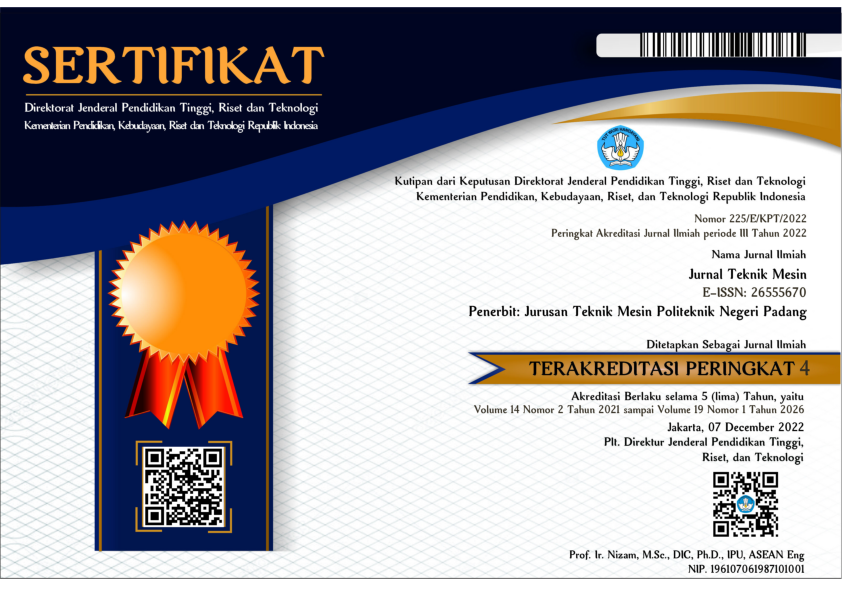Analisis Optimasi Cetakan Briket Sistem Hidrolis Menggunakan Pendekatan Finite Element Method
Abstract
The briquette mold is a critical component in the manufacturing process of the hydraulic briquette molding machine. Improved mold design can increase production efficiency and quality. The finite element method simulates the structural response of the briquette mold to hydraulic pressure. An accurate mathematical model is built based on material parameters, mold dimensions, and hydraulic load characteristics. The influence of mold design variables such as geometry, materials, and internal configuration can be evaluated in detail by applying FEM. Mold optimization uses a numerical optimization algorithm to find a combination of mold parameters that provides the best structural response. The main goal of mold optimization is to increase mold durability, reduce deformation, and minimize the potential for structural failure. The optimization process is integrated with FEM analysis to achieve the optimal mold solution. Improved mold design resulting from this optimization makes a positive contribution to the efficiency of hydraulic briquette production and reduces the potential for mold damage. The results of this research by optimizing the design of the length of the rod, length of the mold, height of the central protrusion of the press, and changing the diameter of the mold, we obtained simulation results that show an even distribution of loads shown in the same color. In this study, the total deformation value was 5.0298 x 10-6 mm and the equivalent elastic strain was 3.4972 x 10-10 mm
References
Arora, J. S. (1993). What is optimization? Structural Engineering in Natural Hazards Mitigation, 1608–1613. https://doi.org/10.1061/9780784402207.ch01
Sulandari, Y. A. S. N., & Pranata, Y. A. (2012). Metode Elemen Hingga Sambungan Balok-Kolom. Jurnal Teknik Sipil, 8(2), 76–141.
Umg, H., & Gresik, U. M. (2020). ( Finite Element Analysis ) By : Hidayat S . T ., M . Eng. June.
Susastro, S., Muhammad, A. F. H., Lostari, A., & Fakhrudi, Y. A. (2021). Optimasi Desain Paddock Stand Sebagai Sistem Statis Dengan Menggunakan Finite Element Method. JRST (Jurnal Riset Sains Dan Teknologi). https://doi.org/10.30595/jrst.v5i1.6023
Insano, S., & Rochardjo, H. S. B. (2023). Optimasi Desain Struktur Train Nose Frame dengan Finite Element Analysis. KONSTELASI: Konvergensi Teknologi Dan Sistem Informasi. https://doi.org/10.24002/konstelasi.v3i1.7089
Dahlan, S., & Al Hakim, R. A. N. (2018). Optimasi Desain Kursi Menggunakan Metode Elemen Hingga. ROTASI. https://doi.org/10.14710/rotasi.20.3.160-164
Elya Heryana, & Karmiadji, D. (2022). Optimasi Desain Pisau Mesin Penghancur Batu Kapur. Teknobiz : Jurnal Ilmiah Program Studi Magister Teknik Mesin. https://doi.org/10.35814/teknobiz.v12i2.3633
Fajrin, M. G. F. G., Widiantoro, H., & Zainuddin, Z.-. (2022). Analisis Elemen Hingga Bagian Penekuk pada Mesin Pembuat Begel Baja Tulangan 8 mm. Suara Teknik : Jurnal Ilmiah. https://doi.org/10.29406/stek.v13i1.4222
Elmiawan, P., Paundra, F., & Pradibyo, G. T. (2022). Optimasi Desain Mesin Punch Menggunakan Metode Finite Element Analysis. J-Proteksion. https://doi.org/10.32528/jp.v6i2.6834
Walidina, M. F., Kardiman, K., & Nugraha Gusniar, I. (2022). Analisis Tegangan Von Mises pada Poros Mesin Penggiling Sekam Padi Menggunakan Software Ansys. Jurnal METTEK. https://doi.org/10.24843/mettek.2022.v08.i01.p05












